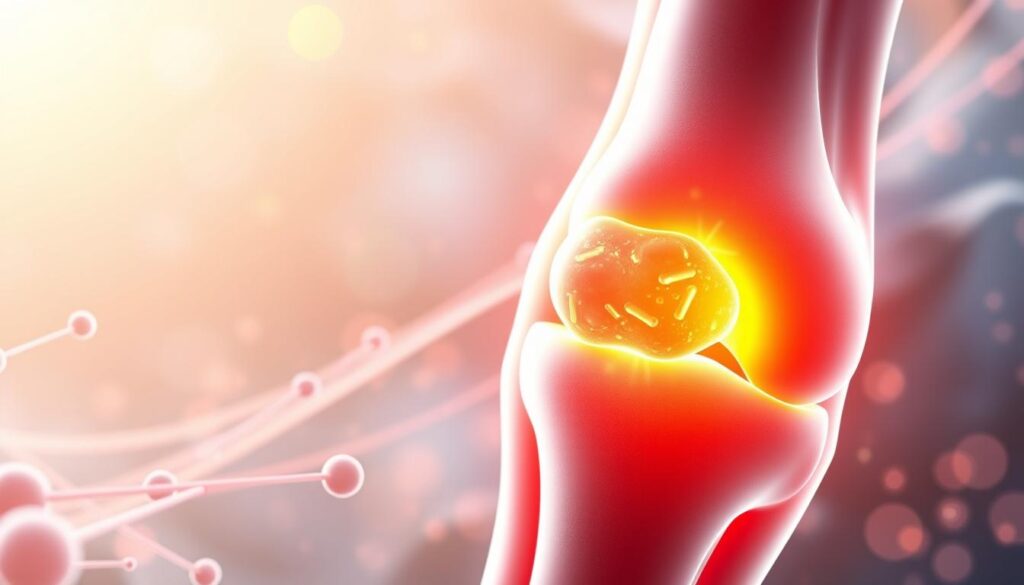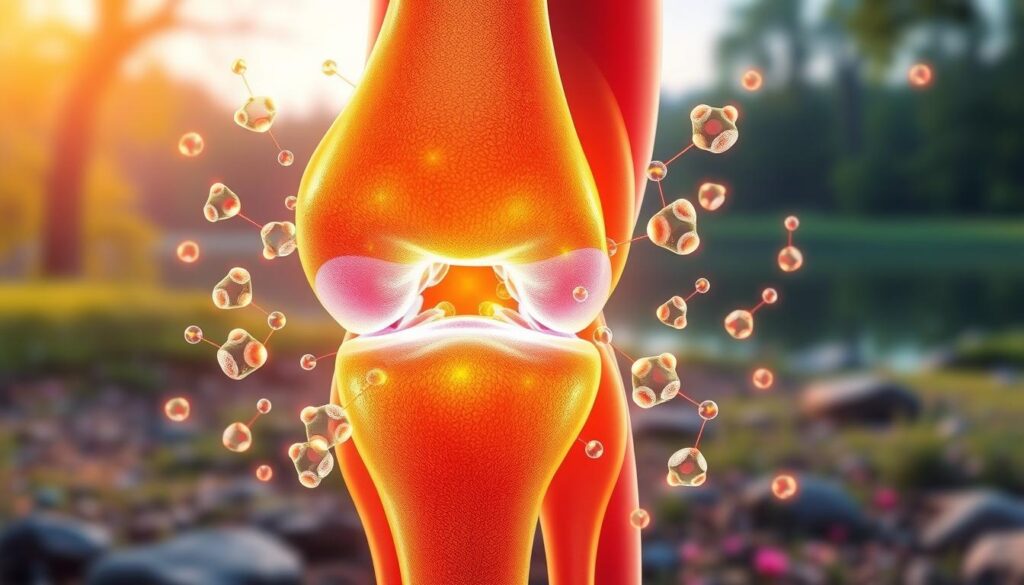A surprising fact is that hyaluronan injections are mainly used for knee osteoarthritis when other treatments don’t work1. It’s a natural substance in our bodies that helps keep joints flexible. Hyaluronan reduces pain and swelling, makes joints move better, and keeps the tissue healthy. This is how it supports joint health.
Key Takeaways
- Hyaluronan injections are used to treat knee pain caused by osteoarthritis1.
- Hyaluronan is a natural substance that is found in the body and is used to lubricate the joints and reduce pain.
- The benefits of hyaluronan for joints include reducing pain and inflammation, improving joint mobility, and promoting healthy joint tissue, which is essential to understand how does hyaluronan support joint health?
- Hyaluronan has been shown to improve symptoms associated with synovitis, such as knee pain, inflamed synovial effusion, and muscle strength2.
- A quarter-teaspoon of hyaluronic acid can hold approximately 1.5 gallons of water, making it an effective substance for joint health3.
- Long-term usage of hyaluronic acid supplements can improve overall skin health, elasticity, and flexibility, which is an added benefit of using hyaluronan for joint health3.
- Hyaluronic acid injections for joint health, mainly for arthritis, should be given by licensed medical professionals and are strictly regulated3.
Understanding Hyaluronan: The Joint Health Molecule
Join the Thousands of U.S. Seniors Enjoying Comfortable, Flexible and Youthful Joints Thanks to Joint Genesis
Hyaluronan, also known as hyaluronic acid, is a key molecule for joint health4. It’s made of sugar units and is found in all connective tissues and organs, like the skin and cartilage4.
In the human body, there’s about 15 g of hyaluronan, with 5 g replaced daily4. Most of it is in the skin, making up half of the body’s total4. Its chains can be up to 25,000 units long, with a weight of 5,000 to 20,000,000 Da4.
Hyaluronan is vital for joint care, acting as a lubricant in synovial fluid4. It helps joints move smoothly and reduces pain5. Studies show that hyaluronan injections can help patients with osteoarthritis for over six months5.
| Benefits of Hyaluronan | Effects on Joint Health |
|---|---|
| Lubrication and friction reduction | Improved joint function and reduced pain |
| Shock absorption and cartilage protection | Reduced risk of joint damage and inflammation |
| Anti-inflammatory effects | Reduced inflammation and improved joint health |
In conclusion, hyaluronan is essential for joint health4. It’s a key component for healthy joints, improving function and reducing pain5.
The Biological Mechanism of Joint Lubrication
The process of joint lubrication is complex. It involves many molecules, with hyaluronan being key. It helps keep joints healthy by lubricating and absorbing shock6. Hyaluronan is vital for joint health and preventing diseases like osteoarthritis. The amount of hyaluronan in synovial fluid is important, ranging from 2-4 mg/ml in human and rabbit knees6.
Hyaluronan’s properties make it a great lubricant and shock absorber. It has a mass of about 3-6 million Dalton and a size of 100-200 nm when hydrated6. This size allows it to reduce friction and absorb shock in joints. Without hyaluronan, joints can become less lubricated and more prone to damage6.
In people with osteoarthritis, there’s less hyaluronic acid. This can harm joint health and hyaluronan’s support role7. Studies use hyaluronic acid with a molecular weight of 2-4 × 10^6 Dalton7. Knowing how hyaluronan works is key to keeping joints healthy and preventing diseases.
Here is a summary of the key points:
- Hyaluronan is essential for joint health, providing lubrication and shock absorption6.
- The right amount of hyaluronan in synovial fluid is important, ranging from 2-4 mg/ml in human and rabbit knees6.
- Without hyaluronan, joints can become less lubricated and more prone to damage6.
As we age, the amount and molecular weight of hyaluronan in our joints can decrease. This affects joint health and hyaluronan’s support role8. Hyaluronan levels in human synovial fluid can range from 1 to 4 mg/ml8. Understanding how hyaluronan works is vital for maintaining joint health and preventing diseases.
| Concentration of Hyaluronan | Range |
|---|---|
| Human and Rabbit Knees | 2-4 mg/ml6 |
| Osteoarthritis Patients | 0.83-2 mg/mL7 |
| Human Synovial Fluid | 1-4 mg/ml8 |
How Does Hyaluronan Support Joint Health? A Scientific Perspective
Hyaluronan is key for joint health. It helps absorb shock, protects cartilage, and fights inflammation. Research shows it can lessen pain and inflammation, keep joints healthy, and stop degenerative diseases9.
Hyaluronan supports joints in many ways. It absorbs shock, protects cartilage, and has anti-inflammatory effects. These actions are vital for healthy joints and preventing osteoarthritis. Studies show hyaluronan injections can ease symptoms for up to a year, and oral supplements can also help10.
Hyaluronan improves cartilage lubrication and joint function. It also reduces pain during osteoarthritis treatment. Plus, it stops the production of inflammatory cytokines, slowing cartilage breakdown10. Hyaluronan’s role in joint health is critical, making it essential for maintaining healthy joints.
| Benefits of Hyaluronan | Description |
|---|---|
| Shock Absorption | Reduces impact of stress and strain on joints |
| Cartilage Protection | Prevents breakdown of cartilage and promotes healthy joint tissue |
| Anti-inflammatory Effects | Reduces pain and inflammation in joints |
Natural Production and Age-Related Changes
As we age, our body makes less hyaluronan, leading to joint diseases like osteoarthritis11. This drop in hyaluronan causes joints to feel stiff and sore. It’s key to boost hyaluronan levels in our bodies12. Supplements can help keep joints healthy and prevent these diseases13.
Studies show we have about 15 g of hyaluronic acid in our bodies, with 5 g replaced each day13. Hyaluronic acid’s size can range from 5,000 to 20,000,000 Da13. Special enzymes called HAS isozymes make different sizes of hyaluronic acid, each controlled differently13.
Using a hyaluronan supplement can ease joint pain and swelling, making it easier to move11. These supplements can also cut down on the need for surgery, with 51% of patients avoiding it after treatment11. They also help lower MMPs, which harm joints13.
| Benefits of Hyaluronan Supplements | Effects on Joint Health |
|---|---|
| Reduces joint pain and inflammation | Improves joint function and mobility |
| Reduces the need for surgery | Decreases the production of MMPs |
Clinical Applications of Hyaluronan in Joint Care
Hyaluronic acid is used in many ways to help joints, like injections, pills, and creams14. It’s good for people with mild to moderate arthritis. It might take a few weeks to start feeling better, and the relief can last months14. Hyaluronan helps by reducing friction and absorbing shock in joints, which is key to understanding its role15.
Some benefits of using hyaluronic acid for joint health include:
- Relief of knee pain from osteoarthritis for up to 6 months16
- Low incidence of local adverse events, indicating a low tolerance issue similar to that of placebo treatments16
- Improved joint function for a significant number of patients14
The concentration and molecular weight of hyaluronan in osteoarthritic joints are lower than in healthy ones16. Knowing how hyaluronan works is key to treating joint health. Hyaluronic acid is a valuable part of these treatments15.
| Treatment | Benefits | Risks |
|---|---|---|
| Injectable Treatments | Relief of knee pain, improved joint function | Bleeding, allergic reactions, pain at the injection site |
| Oral Supplementation | Promotes healthy joints, prevents degenerative joint diseases | Low incidence of local adverse events |
| Topical Applications | Provides lubrication, reduces inflammation | Low risk of adverse events |
Benefits of Hyaluronan for Different Joint Conditions
Hyaluronan is key for keeping joints healthy. It’s a vital part of any joint care plan. Studies show it helps with osteoarthritis, rheumatoid arthritis, and tendonitis16. It cuts down on pain and swelling, supports joint health, and stops joints from getting worse.
Hyaluronan is great for easing pain and swelling. It also helps keep joints healthy15. It has anti-inflammatory effects, which help with conditions like osteoarthritis and rheumatoid arthritis16. Plus, it encourages new tissue growth, helping to fix and protect damaged joints.
Here are some of the benefits of hyaluronan for different joint conditions:
- Osteoarthritis: Hyaluronan can help to reduce pain and inflammation, as well as promote healthy joint tissue16.
- Rheumatoid arthritis: Hyaluronan can help to reduce inflammation and promote healthy joint tissue16.
- Tendonitis: Hyaluronan can help to reduce pain and inflammation, as well as promote healthy tendon tissue15.

In conclusion, hyaluronan is essential for joint health. It’s great for easing pain, swelling, and supporting joint health15. It’s a natural and effective way to care for your joints.
| Joint Condition | Benefits of Hyaluronan |
|---|---|
| Osteoarthritis | Reduces pain and inflammation, promotes healthy joint tissue |
| Rheumatoid arthritis | Reduces inflammation, promotes healthy joint tissue |
| Tendonitis | Reduces pain and inflammation, promotes healthy tendon tissue |
Optimal Dosage and Administration Methods
Join the Thousands of U.S. Seniors Enjoying Comfortable, Flexible and Youthful Joints Thanks to Joint Genesis
Getting the right amount of hyaluronan is key for joint support. The daily dose is usually 50-200 mg17. You can take it in different ways, like shots, pills, or creams. Hyaluronan helps keep joints smooth and reduces pain as we age17.
When you take hyaluronan, timing and what you eat matter. A 2023 study showed that 72% of patients got better after a hyaluronic acid shot17. Also, hyaluronic acid is used in many beauty treatments to fill in lost volume18.
How much and how you take hyaluronan depends on your needs and health. Always talk to a doctor to find the best way to use it. This way, you can keep your joints healthy and strong.
Here are some important things to remember about hyaluronan supplements:
- Recommended daily intake: 50-200 mg per day17
- Forms of supplementation: injectable treatments, oral supplementation, and topical applications17
- Timing and absorption factors: time of day, presence of other nutrients17
- Clinical benefits: pain relief, improved mobility, and reduced stiffness17
Knowing these points helps you make smart choices about your hyaluronan use. This way, you can keep your joints in top shape.
Potential Side Effects and Considerations
When looking at the hyaluronan benefits for joints, it’s key to also think about the possible side effects. Research shows that hyaluronic acid injections are mostly safe. But, they might cause temporary pain or swelling in the knee19. You might also feel stiff or have muscle pain19.
Less common issues include swelling or redness in the joints. You might also have reactions at the injection site19.
It’s also important to think about how hyaluronic acid affects joint health and its interactions with other drugs. Studies show it can help with pain and improve life quality for those with knee osteoarthritis20. But, side effects are rare, happening in about 1-2% of cases20.
When it comes to facial cosmetic surgery, hyaluronic acid fillers are mostly safe. They have a 5% rate of adverse events, mostly mild and short-lived20. The effects of hyaluronic acid on aging can also vary. This depends on genetics, diet, and lifestyle21. People with severe allergies should be careful when using these products21.
In summary, hyaluronic acid is generally safe. But, knowing the possible side effects and considerations is important. This way, you can make smart choices about your joint health and treatment.

- Potential side effects: temporary pain or swelling, difficulty with movement, muscle pain or stiffness, and joint pain19
- Importance of considering interactions with other medications
- Safety profile of hyaluronic acid fillers in facial cosmetic surgery20
- Variability of anti-aging effects depending on individual factors21
Conclusion: Maximizing Joint Health with Hyaluronan
Hyaluronan is a key player in keeping our joints healthy22. It acts as a lubricant and shock absorber, protecting cartilage and reducing inflammation22. Knowing how hyaluronan works helps us take care of our joints and avoid conditions like osteoarthritis23.
Hyaluronan fights inflammation and pain, making it a great tool for joint issues22. Supplements and treatments can boost its natural production. This improves joint function and overall health23.
Osteoarthritis is becoming more common23, so keeping our joints healthy is vital. Adding hyaluronan to our health routine can help manage pain, enhance mobility, and stop joint damage22. With the right information, we can all improve our joint health and live more comfortably.
FAQ
What are the benefits of hyaluronan for joints?
How does hyaluronan work to support joint health?
What is the role of hyaluronan in joint care?
How can hyaluronan supplements benefit joint health?
What are the possible side effects of using hyaluronan for joint care?
Source Links
- Hyaluronan injections – https://versusarthritis.org/about-arthritis/treatments/drugs/hyaluronan-injections/
- Oral hyaluronan relieves knee pain: a review – https://pmc.ncbi.nlm.nih.gov/articles/PMC4729158/
- Hyaluronic Acid: What It Is, Benefits, How To Use & Side Effects – https://my.clevelandclinic.org/health/articles/22915-hyaluronic-acid
- Frontiers | Hyaluronic Acid: Molecular Mechanisms and Therapeutic Trajectory – https://www.frontiersin.org/articles/10.3389/fvets.2019.00192/full
- Hyaluronic Acid for Skin, Eye, and Joint Health – https://www.verywellhealth.com/hyaluronic-acid-supplements-89465
- Hyaluronan, the guardian of joints – https://www.physoc.org/magazine-articles/hyaluronan-the-guardian-of-joints/
- Potential Lubricating Mechanism of Hyaluronic Acid for a Reduction of Albumin-Mediated Friction in the Artificial Joint System – https://www.mdpi.com/2075-4442/11/5/210
- Hyaluronan concentration and size distribution in human knee synovial fluid: variations with age and cartilage degeneration – Arthritis Research & Therapy – https://arthritis-research.biomedcentral.com/articles/10.1186/s13075-016-0922-4
- Hyaluronic acid for osteoarthritis: Benefits and risks – https://www.medicalnewstoday.com/articles/hyaluronic-acid-for-osteoarthritis
- New Hyaluronic Acid from Plant Origin to Improve Joint Protection—An In Vitro Study – https://pmc.ncbi.nlm.nih.gov/articles/PMC9332867/
- Effectiveness and utility of hyaluronic acid in osteoarthritis – https://pmc.ncbi.nlm.nih.gov/articles/PMC4469223/
- Why Seniors Should Consider Hyaluronic Acid for Bone and Joint Health – https://santosmedical.com/why-seniors-should-consider-hyaluronic-acid-for-bone-and-joint-health/
- Hyaluronic Acid: Molecular Mechanisms and Therapeutic Trajectory – https://pmc.ncbi.nlm.nih.gov/articles/PMC6603175/
- Viscosupplementation Treatment for Arthritis – https://www.hopkinsmedicine.org/health/conditions-and-diseases/arthritis/viscosupplementation-treatment-for-arthritis
- Hyaluronan and synovial joint: function, distribution and healing – https://pmc.ncbi.nlm.nih.gov/articles/PMC3967437/
- Intra-articular hyaluronan (hyaluronic acid) and hylans for the treatment of osteoarthritis: mechanisms of action – Arthritis Research & Therapy – https://arthritis-research.biomedcentral.com/articles/10.1186/ar623
- No title found – https://www.arthritis.org/health-wellness/treatment/treatment-plan/disease-management/hyaluronic-acid-injections-for-knee-pain
- Hyaluronic Acid – StatPearls – NCBI Bookshelf – https://www.ncbi.nlm.nih.gov/books/NBK482440/
- Hyaluronic acid (injection route) – https://www.mayoclinic.org/drugs-supplements/hyaluronic-acid-injection-route/description/drg-20074557
- HYALURONIC ACID: Overview, Uses, Side Effects, Precautions, Interactions, Dosing and Reviews – https://www.webmd.com/vitamins/ai/ingredientmono-1062/hyaluronic-acid
- Hyaluronic acid: Uses, side effects, and risks – https://www.medicalnewstoday.com/articles/326385
- Potential mechanism of action of intra-articular hyaluronan therapy in osteoarthritis: are the effects molecular weight dependent? – PubMed – https://pubmed.ncbi.nlm.nih.gov/12219318/
- Role and Effectiveness of Intra-articular Injection of Hyaluronic Acid in the Treatment of Knee Osteoarthritis: A Systematic Review – https://pmc.ncbi.nlm.nih.gov/articles/PMC9135165/


